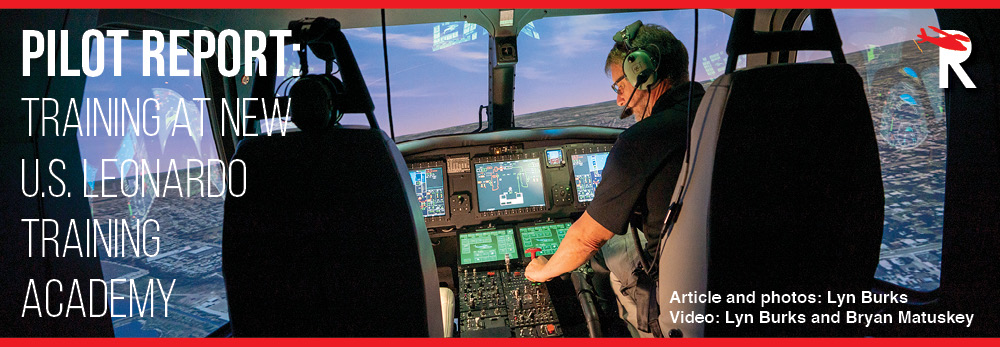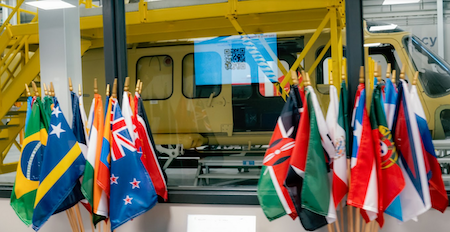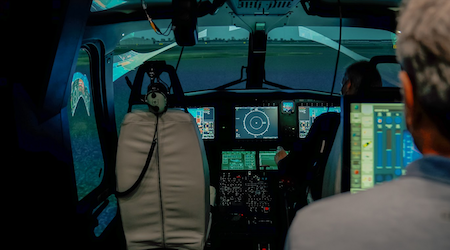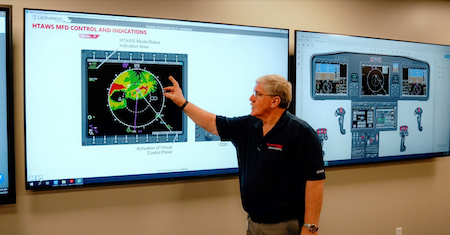|
Nov
15
2021
|
|
Posted 4 years 56 days ago ago by Admin
|
|

WATCH PILOT REPORT VIDEO FEATURE
In 2018 I attended the Leonardo Helicopters AW169 initial training course at the OEM’s training facility in Sesto Calende, Italy. Northern Italy in spring—what’s not to love?
WATCH VIDEO OF MY 2018 AW169 TRAINING HERE:
https://youtu.be/fwt_We3D4mY
Although both my training and tourist experiences were amazing while I attended the Sesto Calende academy, it was a significant trek to attend a training course so far from home. With all the Leonardo Helicopters being flown in the Western Hemisphere, it seemed to me that there would be significant value in a U.S.-based training academy.
Well, not long after that thought while at the academy in 2018, I was interviewing Paolo Petrosso, VP of Leonardo Helicopters Training-Italy when he pointed to the future by saying, “In the future we are certainly looking to expand our footprint around the globe. One of the key areas we are looking at is AW169 training in the U.S. We certainly need to provide simulation capabilities in the U.S. and North America, and that is something we are looking at right now.”
The future is now
My first training experience with Leonardo Helicopters (AgustaWestland at the time) in the U.S. was back in 2004. I was hired by a large energy company to fly an AW109E helicopter and was sent to the training academy in Philadelphia to complete the AW109E initial training course. At the time, the course pretty much consisted of ground school as well as a couple hours of training in our company aircraft with an Agusta instructor pilot. My, how times have changed.

Fast forward to 2021: Despite the challenges of COVID-19, this past spring Leonardo opened its brand new, state-of-the-art Helicopter Training Academy located on their existing campus in northeast Philadelphia that also includes production, support and administrative functions for the United States. The $80 million facility investment is aimed at providing training services for a growing demand and need for pilots, cabin crews, and maintenance technicians across North and South America.
This past August I visited the new facility to not only write about the new academy for Rotorcraft Pro, but I was also there to attend the week-long AW169 recurrent training course as a pilot.
The big picture
In 2019, the Leonardo customer base for the popular AW139 and 169 was continuing to expand and the company recognized that it needed more training capacity in the Western Hemisphere to meet rising demand. The company made a commitment to the industry that it would have a training facility built, opened, and operational in the U.S. by Q1 2021. In the spring of 2020 when the global pandemic hit, one might think that development of the new academy would have suspended, but it did not. Terry Eichman, the U.S. academy’s head of training operations said, “Once COVID hit, we took the opportunity to reprogram our construction team and we pushed into this to achieve one thing (complete the project). And in the first quarter of this year we were fully functional, capable, certified, and delivering training. We are fortunate to have that team, and it’s not lost on me or our organization of that achievement in that time frame.”
The new 63,000 square foot U.S.-based training facility is set up to serve virtually every sector of the industry from which its operators come. Those sectors include air ambulance, law enforcement, military, corporate, and offshore oil support to name a few. Geographically, the academy is located to primarily serve Leonardo operators and clients in the Americas, which includes Canada, the U.S., and Central and South America.

Uniquely, the company does not see training merely as a side product that’s required after purchasing one of its helicopters, but as an extension of a partnership between the OEM and the operator. “Leonardo Customer Support and Training (CS&T) is about valued, long-lasting relationships with our customers and partners. Training is an integral part of the mutual commitment that fills a continued safety performance connection,” said Vittorio Della Bella, Leonardo’s senior vice president of CS&T.
The U.S.-based facility is designed to provide highly technical training to both pilots and mechanics. The current training courses offered center around operators who are flying AW139, 169, 119, and 109 aircraft. The academy will soon be introducing a curriculum for the AW609 that will include maintenance, avionics, electrical, and pilot training programs. Currently the academy is open six days per week and it is anticipated that approximately 1,200 customers will be trained this year. Giving a glimpse into the future, Terry Eichman, the U.S. academy’s head of training operations indicated, “With our current space, staff, and capabilities, we are programmed to handle approximately 3,000 customers per year.
My personal experience in AW169 recurrent training
As stated earlier, my primary purpose for visiting the academy was to attend and complete the AW169 recurrent training course.
Upon my arrival at the sprawling Leonardo Helicopters facility, my first stop was to check in with security and obtain a badge that would be used to enter the training facility. For pilots and mechanics in training, this will be a daily occurrence as access is tightly controlled at the facilities. After entrance to the training facility and signing in, I was greeted and given a tour of the facility in order to get the lay of the land.

The ground training was performed in a modern classroom with several high-tech visual training aids. There’s also a lower tech, but equally important training room which houses the various airframes and system components. This is where clients can see many of the helicopter systems broken down into parts. This allows clients (pilots and mechanics) to get their hands on many of the components in order to discuss them with the instructor and gain a better understanding of their operation. The recurrent ground training course for the AW169 is two full days in the classroom thoroughly covering every system from electrical, to powerplant, to drivetrain, to hydraulics and everything in between. Although there is a lot of content to cover in two days, it was very manageable. The two-day course culminates in a written test prior to moving on to the flight simulation phase of training.
The simulation training is basically broken into three distinct sorties with each being two hours in length and spread out over a couple days. Each simulation session is accompanied by a 30 to 60 minute pre- and post-flight briefing and debriefing.
Sortie #1 is VFR operations. The first 20 - 30 minutes are used for start-up, running checklists, and flying a couple traffic patterns in order to get the feel of the simulator. The remaining 90 minutes are used to perform Category A and B takeoff and landing operations, followed by a series of escalating emergency procedures that range from a generator failure, to an engine fire and failure, to the dreaded tail-rotor failure. The emergency procedures training is probably the most challenging, but useful training as you are required to split your attention between flying the aircraft and working the emergency procedures checklist.

Sortie #2 switches gears and focuses primarily on IFR operations. Being that I had not flown a helicopter in an IFR environment in a while, my instructor, Captain Greg Falcinelli, did an excellent job in the preflight brief refreshing my memory on certain aspects of IFR ops in preparation for going into the simulator. Once in the simulator, there’s no wasting time. The initial focus is on getting the flight plan set up in the flight management system, obtaining a clearance, then you takeoff and go straight into the soup!
Once in the clouds and on course, there’s a pause in the flight plan and some practice time was given to evaluate and hone some IFR hand flying skills, which includes things like steep turns and unusual attitude recovery. Once back on course with the original flight plan, some changes in the flight plan are made, which allowed myself and the instructor to go a little deeper with respect to the nuances of the flight management system. Along the way, you can also expect several emergencies related to the electrical and autopilot system. We were also able to fly several different IFR approaches, both by autopilot and by hand. Hint: don’t be surprised if by the end of the flight you find yourself hand flying an ILS to minimums on one engine!
Sortie #3 is a proficiency check that splits the time between the VFR maneuvers, IFR procedures, and emergency procedures learned in Sorties 1 and 2. In the end, the simulation training consisted of 6 hours of simulated flight. At the end of both the ground and simulation training I felt completely confident and refreshed from a knowledge and skills standpoint as any good recurrent training course should do.
Technology and people are the center of it all
The training academy facilities are basically broken up into five different areas: classrooms for ground training, simulation bay for flight training, airframe and component bay for pilot and maintenance training, administrative areas, and client amenity areas, which include a cafe, a workout space, as well as client rest and study rooms.
Naturally, the ground training classrooms and the flight simulation areas are where the bulk of training occurs. At the core of virtually every training method, technology is used to improve and enhance the way clients learn to fly, operate, and maintain their aircraft.

In the classrooms, each client is equipped with computer stations and iPads in order to access training aids and related training manuals. For example, prior to stepping foot into the full-flight simulator, emergency procedures can be run from the classroom white board in which the instructor can fail individual systems, such as electrical or hydraulics. This allows the student to see the full cockpit instrumentation and visualize what indications will be seen in the cockpit, as well as how individual aircraft systems will be affected on systems synoptic pages.
Without a doubt, the benefits of the advanced ground training prepares students as they transition over into the simulation training, which uses some of the most advanced helicopter simulation technology in the world. On the subject of training and technology, Eichman said, “Leonardo is a technology company. We have a team of training specialists and engineers dedicated to the development of training devices with advanced capability.” The academy’s newest simulator, the AW169 is equipped with a 12-foot dome, high-definition audio and visual projections, and a high-fidelity electronic motion and feedback system.
Technology development is so integral to Leonardo’s holistic approach to its clients that it has created a new concept called the ‘digital twin.’ Vittorio Della Bella said, “The digital twin is one of the most modern concepts that we are trying to deliver in a concrete way.” He went on to use the AW169 as an example by explaining that the aircraft, simulators, and training products are developed in-house and with no third parties. The benefits of this digital-twin concept is that it allows connections between the aircraft, training, and simulator to maintain timely continuity and alignment as changes occur to the aircraft.
Naturally as the client base continues to expand, training and technology development cannot happen without people. Developing a capable and competent team has become one of the company’s top priorities. “Our Leonardo family of professionals are the key to our industry success,” says Della Bella, “We are committed to attracting, retaining, and mentoring our people, creating a common focused purpose of exceptional products, services, and customer experiences throughout our global Customer Support and Training operations.”
Given my personal experience having trained at Leonardo in both Italy, and the U.S., I believe that commitment is real.
WATCH VIDEO FEATURE